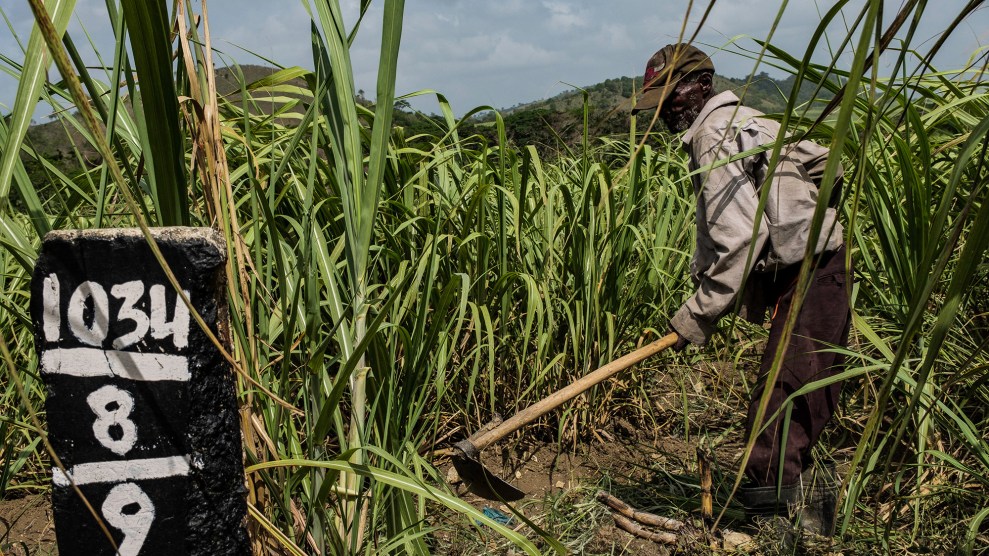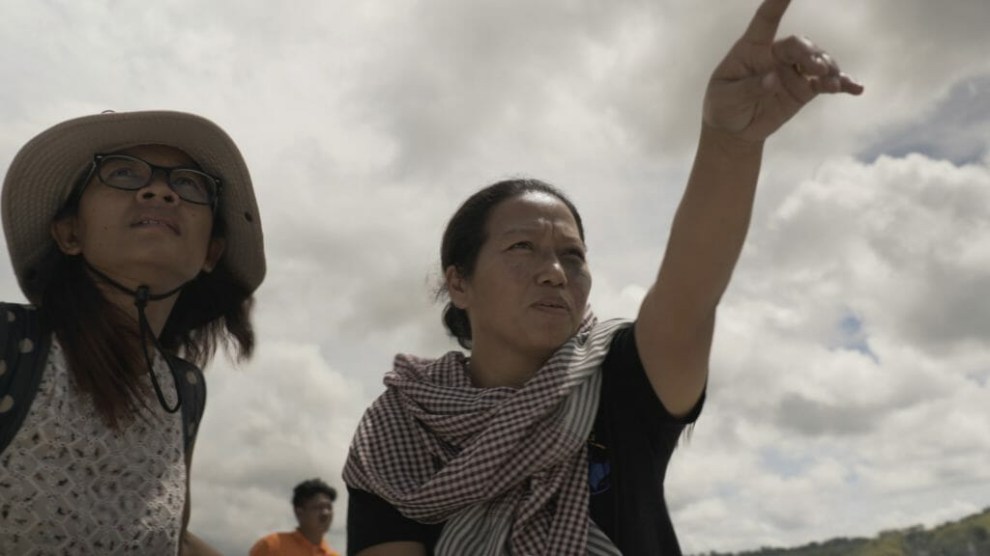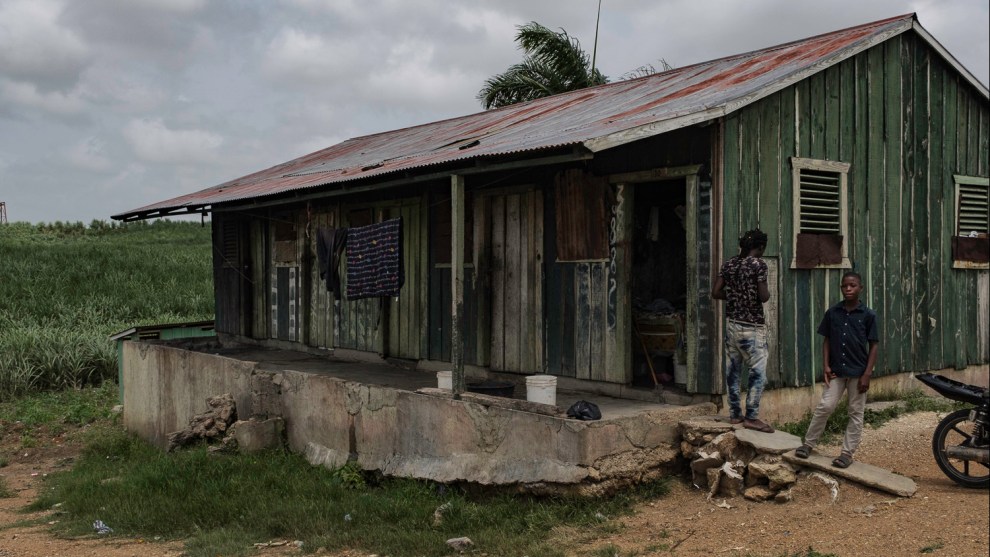
A building in Hoyo de Puerco in August. The encampment was recently demolished.Pedro Farias-Nardi
On a November day in a remote corner of the Dominican Republic, a line of trucks rolled across a vast sugarcane plantation and pulled up at a cluster of rickety shacks and barracks. The settlement, known to residents as Batey Hoyo de Puerco, or Pig Hole, was home to an estimated 230 Haitian cane cutters and their families.
Men with hammers and iron mallets stepped out of the trucks, accompanied by armed security guards. They worked for the billion-dollar Central Romana corporation, one of the biggest suppliers of raw sugar to the United States. Their cane is packaged as Domino sugar and folded into Hershey’s chocolate and other manufacturers’ sweets.
The workers’ job on that scorching day: knock down the slumping tin-roof structures and make way for bulldozers to finish the demolition. Within days, Hoyo de Puerco was flattened and its residents loaded onto trucks and distributed to nearby settlements, some with little or no warning or explanation.
“They didn’t tell me anything,” said one former resident, who like others requested anonymity out of fear of retaliation from the company. “They just came and started breaking houses.” She and other former residents said some families were separated in the relocation. “Now I am far from my mother,” she said.
Another resident said she saw “more than 25” men come in with three bulldozers to raze the settlement, known as a batey, to the ground. “I didn’t have much time to collect my stuff,” she added, describing how a company supervisor ordered her to hurry. “I had 28 years in the batey and I had to leave, rushing. All my stuff was on the floor. It was very frustrating.” While Central Romana officials insist “the process went very smoothly” and residents were given more than a month’s notice, other eyewitnesses described a rushed demolition in which residents received no advanced warning.
The settlement’s demolition is just one of a wave of actions taken by Central Romana following a two-year investigation released in September by Mother Jones and Reveal from the Center for Investigative Reporting. The reports exposed the company’s treatment of its workers: substandard housing, hazardous working conditions, low wages, poor access to medical care, and the massive debt they often incur.
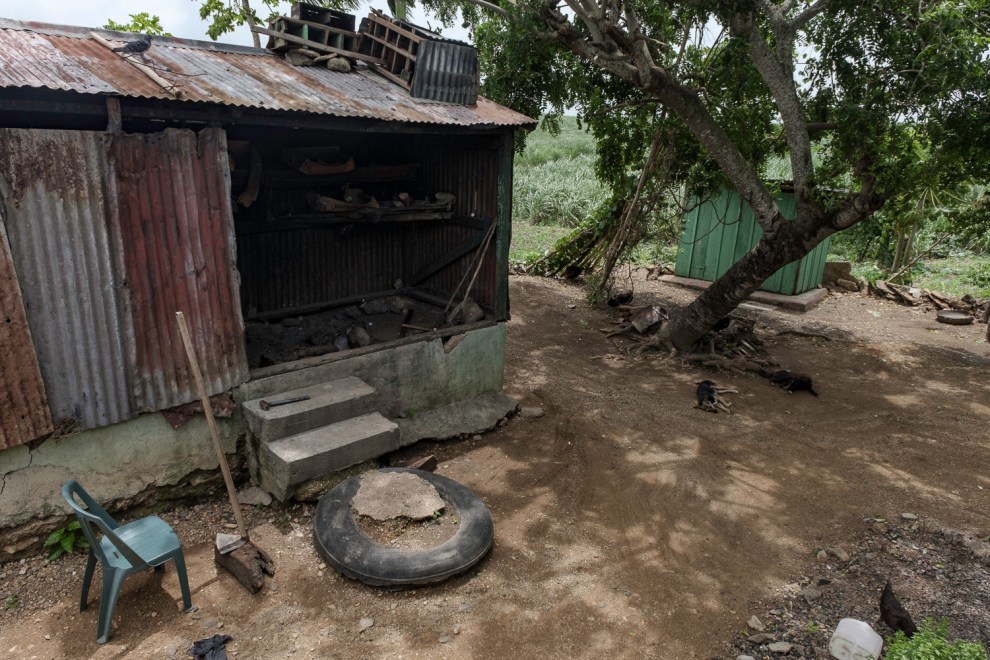
A building in Hoyo de Puerco, before its destruction.
Pedro Farias-Nardi
In all, nine former residents and aid workers described how Hoyo de Puerco was destroyed in mid-November, accounts that were corroborated with photos and video. In a December 14 email, Central Romana confirmed that Hoyo de Puerco, known to the company as Batey 82A, was “eliminated” in November. “It did not meet our standards,” said company spokesperson Jorge Sturla, claiming the teardown was part of a broader batey “improvement” program launched in 2010.
But Hoyo de Puerco had remained standing and in poor condition for 11 more years. In a scathing 2015 report by the Inter-American Commission on Human Rights, the settlement was cited for “deplorable” and “overcrowded” conditions that trapped residents in “a tragic cycle” of “almost inescapable” poverty. But it was only last month, as the company faced growing criticism in Washington, and just days before a visit to the plantation by US diplomats, that it was destroyed. On November 23, officials from the US Embassy in Santo Domingo toured Central Romana’s plantation, including bateyes and cane fields, to assess the company’s operations, according to a Department of Labor spokesperson. (The department helps monitor the Dominican sugar industry under the terms of an international trade agreement.)
Central Romana denies that it separated any households, saying workers and their families were moved to nearby settlements with “better houses”—either newly built or “completely repaired.” But one former resident of Hoyo de Puerco says the house he was relocated to in a nearby batey is in worse shape than the one he was forced to leave. “It’s full of holes, so when it rains, the water comes inside,” he says, complaining that CR promised, but didn’t make, repairs by a date that has long past; the company says it will look into the issue.
Like many other bateyes, Hoyo de Puerco bore little resemblance to the gleaming housing touted online by Central Romana. The company’s website outlines a corporate social responsibility program and boasts of providing its Haitian workforce and their families with free health care and housing while treating them “with dignity and respect.” The company says it has invested $12 million in the bateyes over the past five years and that it complies with the minimum daily wage set for the industry in the Dominican Republic of about three and a half dollars.
In repeated visits over the past two years to some two dozen bateyes on Central Romana’s plantation, journalists from Mother Jones and Reveal documented wretched conditions in company housing. Hoyo de Puerco was full of dank, crumbling dwellings, with bare mattresses or single sheets passing for bedding on the concrete floors. Like an estimated 90 percent of Central Romana bateyes, Hoyo de Puerco had no electricity. According to paystubs collected in 2020 and 2021, workers earn only around $3.37 for each ton of cane they cut.
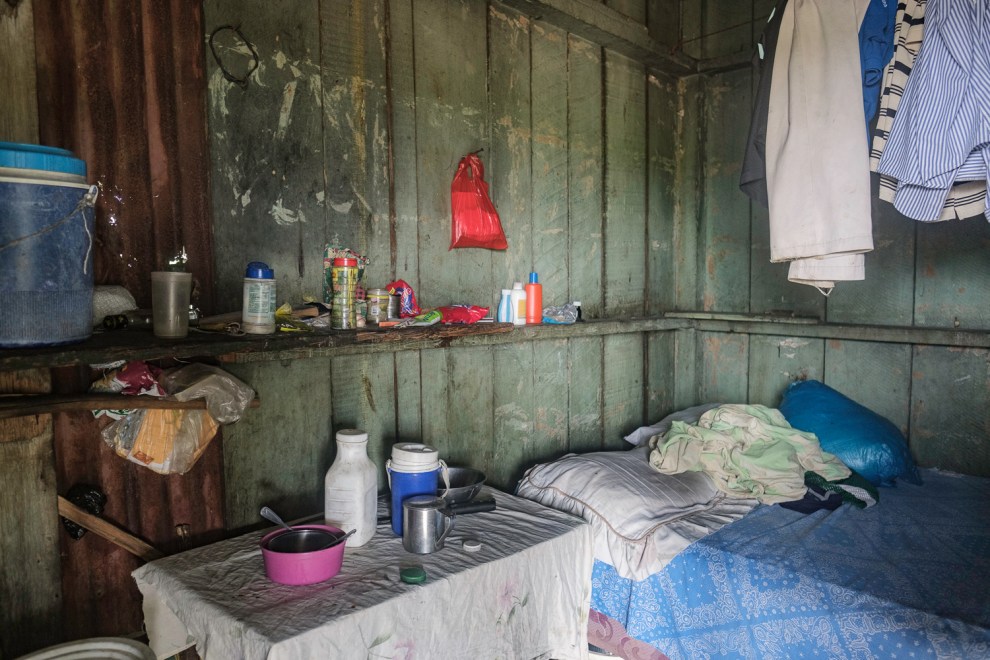
Inside one of the now destroyed homes.
Pedro Farias-Nardi
Central Romana denied that Hoyo de Puerco’s demolition was related to the US diplomats’ visit, though Sturla, the company spokesperson, confirmed they visited the barren site. “It was critical to move our workers and their families to better places,” he wrote. Officials from the embassy and the Department of Labor declined to comment on the timing of the destruction.
Billionaire Florida brothers Alfy and Pepe Fanjul bought Central Romana with a group of investors in 1984. The family retains a large interest in the company, according to a Fanjul Corporation spokesperson. Central Romana and other sugar companies associated with the Fanjuls have long been subject to lawsuits and critical media reports over poor conditions faced by their workers and the company’s destruction of housing. A key development took place in 2004 when, as part of a regional trade agreement, the Dominican Republic committed to adhere to broad worldwide labor standards. In 2013, amid growing global criticism of the Dominican sugar industry, the US Department of Labor authorized related monitoring visits to the cane fields by its international wing.
Since then the labor department has issued regular reports documenting improvements, particularly in reducing child labor and illegal human trafficking. But the reports also cited resistance among some Dominican sugar companies. The department refused to name any companies or specific violations, or to release relevant documents requested under the Freedom of Information Act.
A collection of heavily redacted field reports, made public only after Reveal sued the Labor Department, detail US monitors’ concerns about Central Romana or its suppliers’ operations, including cane cutters who walk 12 miles to and from the fields and perform 13-hour work days with “none getting a day of rest.” (Central Romana says it provides transportation and denies workers put in “more than 8 hours.”)
The undated document also cites “old barracks that housed families in tiny rooms with open water on the ground and no bathroom”—an apt description of the living conditions found in Hoyo de Puerco and many other bateyes.
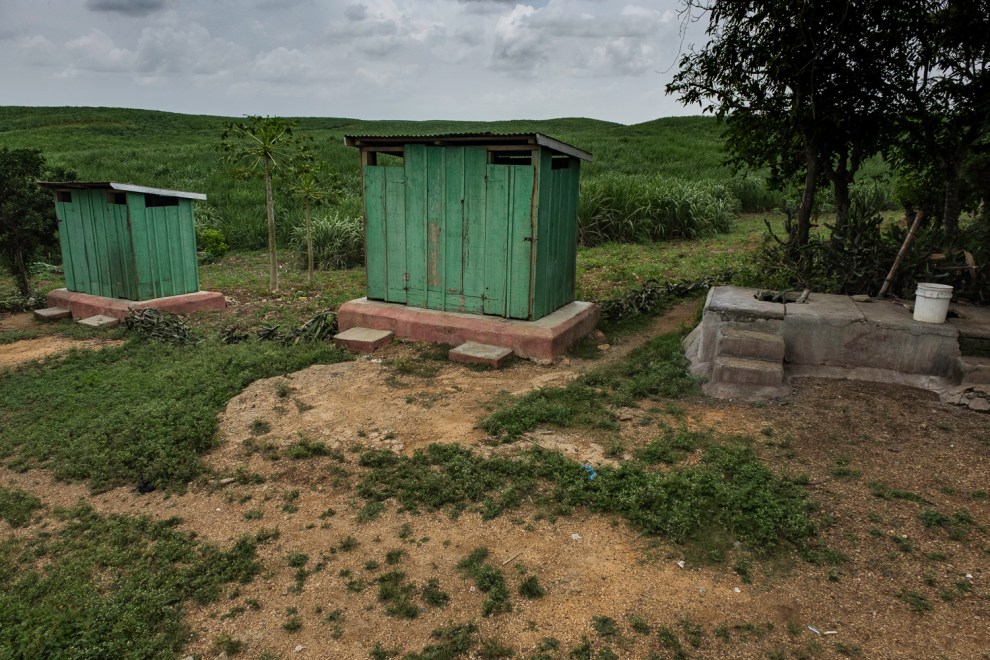
Outhouses that once stood in Hoyo de Puerco.
Pedro Farias-Nardi
Lawmakers in Washington are souring on the Dominican sugar industry. In October, 15 Democratic members of the House Ways and Means Committee called on the Biden administration to “investigate human trafficking, forced and child labor, hazardous working and living conditions, and other labor rights violations in the Dominican sugar industry.”
The committee members’ statement came as a direct result of the Mother Jones and Reveal stories, as well as reporting by the Washington Post. Those reports “raise grave concerns of continued inhumane conditions that we simply cannot tolerate in our supply chains,” according to the statement, which called on the administration “to ensure that the United States is aggressively working to end these outrageous, abusive practices.” (In response, Central Romana points to comments from Dominican lawmakers and a local labor group that includes the company’s union insisting the statement contains false accusations.)
In an interview, committee member Earl Blumenauer (D-Ore.), chair of the Subcommittee on Trade, expressed frustration that, despite 10 years of monitoring of the Dominican Republic’s sugar sector, labor standards are still falling short. “The U.S. government hasn’t been able to follow through on this,” Blumenauer said.
“I don’t think we have seen aggressive efforts to police, monitor and maintain the agreement,” Bluemenauer added. “There is persuasive evidence of abuses. It shouldn’t be this hard.”
Across Central Romana’s 166,000-acre plantation, thousands of Haitian workers still cut the cane by hand, using machetes. After processing, Central Romana exports much of the resulting raw sugar to the ASR/Domino refinery in Baltimore. ASR bills itself as the world’s largest sugar refiner.
The Fanjuls, a politically influential family that has donated tens of millions of dollars to US politicians on both sides of the aisle, benefit from low tariffs and congressionally approved sugar price supports, which annually gain their companies by an estimated $150 million, according to Montana State University economist Vincent Smith. According to the paystubs and a 2021 canvas of dozens of workers, laborers on Central Romana’s sprawling plantation are paid as little as $4 per day.
As Central Romana has faced growing scrutiny from outsiders, it has stepped up armed patrols by its rifle-toting security forces, according to multiple sources. “Now there is a more permanent system of surveillance,” said Jesús Nuñez, president of the independent Union of Sugarcane Workers. “Every hour there’s a member of security observing.”
Multiple eyewitnesses reported seeing guards armed with shotguns patrolling on motorcycles. “They go to the bateyes all the time,” said a local resident. “They don’t go [any longer] to one or two bateyes, now they go to like six or 10.” Nuñez said he believed the increased surveillance was a direct result of recent media reports, including those from Mother Jones and Reveal. “Romana does not like that people step on their tail,” he said.
Central Romana called the reports of increased surveillance “completely untrue,” with Sturla claiming “there hasn’t been any reason to increase the presence of our security personnel.”
Nuñez and aid workers say Central Romana’s armed security force is also being used to carry out evictions from other bateys. “Many of these folks are retired cane workers who really have nowhere to go,” according to an aid worker who frequently visits the plantation and requested anonymity to protect their access.
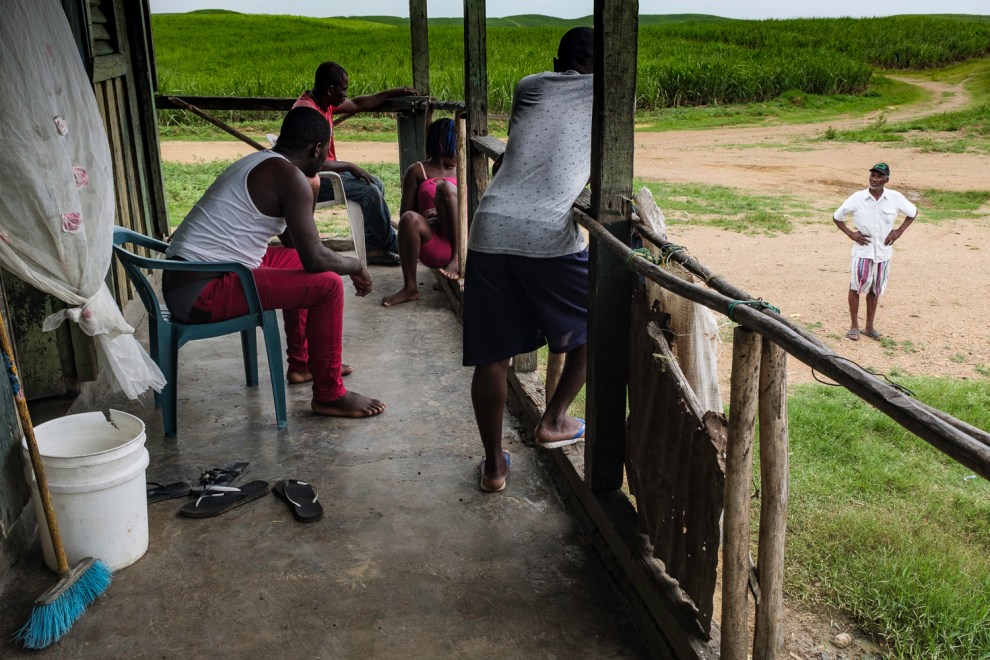
Hoyo de Puerco residents before their relocation.
Pedro Farias-Nardi
In some cases, widows whose husbands worked for Central Romana for decades have been evicted, forcing them to find housing in nearby towns. Company officials confirmed that it evicts retired workers and widows in an August email.
Central Romana can take such actions, Nuñez says, “because it is a government within a government.” The company is a hugely influential economic and political player in the Dominican Republic. It owns nearly a quarter million acres of land, its own port, international airport, cattle operation, and a 7,000-acre five-star resort on the Caribbean shore. Central Romana is one of the country’s largest private employers. Its past president served as the country’s vice president, foreign minister, and ambassador to the United States. In a statement, the Fanjul Corporation insisted that “Central Romana is a highly respected corporate citizen in the Dominican Republic and takes pride in its reputation for civic activities and ethical business practices.”
Congressional sources and labor advocates say concern over working and living conditions in the Dominican sugar industry is now spreading from Congress to other federal agencies, and to candy companies, including end users like Hershey. Their website highlights human rights and sustainability policies on sourcing cocoa, but says little about sugar. The company declined interview requests.
Hershey isn’t the only chocolate company to make such commitments about cocoa. “There’s been some real progress with cocoa,” notes Blumenauer, but “no one really pays attention [to sugar]…I think there needs to be attention.”
Blumenauer is optimistic that will change: “These are very wealthy people, profitable companies, and being able to give people a basic, decent treatment is within their capacity. There was a time when people thought you couldn’t get soccer balls unless they were sewed by little tiny fingers. Well, we’ve had compliance. It’s changed the supply chain. And I think we can do the same with sugar.”
As for the former residents of Hoyo de Puerco, the conditions were tough but some still miss their old homes. “I was born there. I had my children there, my neighbors, my community,” said one woman. She recalled the last glimpse she had of the village, sitting in a pickup truck alongside piled-up furniture, rolling to a new home. “The bulldozer was there,” she said. “There were only 11 houses left standing. I felt bad, but what can you do?”
This story was developed in partnership with Reveal from the Center for Investigative Reporting and with support from the Pulitzer Center on Crisis Reporting. Special thanks to Michael Montgomery.
